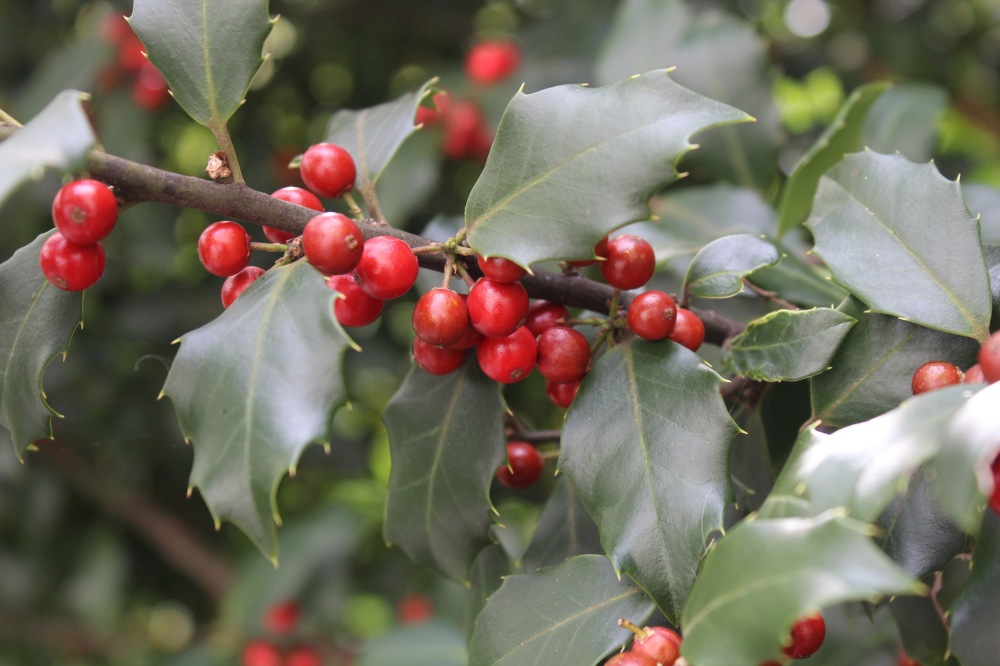Occasionally, I am almost convinced that I know a thing or two about the garden. Not often, and though I might speculate about one aggravation or another, mostly I’m just guessing. Term these educated guesses if it pleases you. I’m not offended knowing that the mysteries of the garden are above my mental capabilities.
Happily, it appears that I’ve solved the “no berries on the Winterberry hollies” dilemma. For years there were loads of berries on the grouping of five or six hollies. But, these were planted beside a grove of bamboo, that spread as bamboos do, and eventually a few of the hollies were too close and shaded out. For other reasons, and here some part of the blame (or credit) goes to my wife, the bamboo was chopped out. Once gone, a Winterberry or two was also lost and dug out.
Then, with more sunlight and what should have been a more advantageous situation, the hollies ceased to have more than a few scattered berries. Please excuse my advice over the years that there is always a male pollinator nearby, because, in this case, apparently there was not. And also, it seems that the male was one of the hollies that was dug out. This revelation took only two or three years to confirm, and then I was distracted for another few years before planting a small male holly nearby earlier this year.

Miraculously, this tiny holly provided the right stuff to pollinate the four remaining female hollies, that are now covered in berries. In early autumn, these are ripening to red. So, all is well, and with renewed faith that I’m not a complete dunce, I will continue to spout “wisdom”.
And really, this problem should not have been so complicated, and no doubt was perplexing only because I was quite certain that there is always an available pollinator. Perhaps, I will know better next time.
Dear Dave. I love your blog and think you do indeed have wisdom about the garden. But, I do not. That is one reason why I love reading about your garden. So, here is an incredibly dumb question probably…how do you know if the plant is make or female??? I am honestly asking a legitimate question!
Many thanks !
🙂
Besides reading a tag, this is not a simple matter. Some plants have male and female flowers on the same plant (monoecious), or flowers have both stamens and pistils, so a separate pollinator is not necessary. There are identifying characteristics to identify the sex of flowers, but this is beyond most gardeners’ (and my) capabilities. Both male and female plants flower, but only the female flower will develop fruits or berries.
Dave….am often in awe of your commentary because it’s laced with humility. My recent experience with our one prized Winterberry is similar to yours. For two years after planting beside our driveway and in a mostly-shaded area, it grew well, but no berries. I thought we had a dud, but after visiting two respected nurseries (one of them yours) and getting consensus from two knowledgeable nurserymen, we purchased a Southern Gentleman holly (which is supposed to be a male capable of pollinating the female Winterberry). For the first year (2016) nothing happened on the male other than some little bud-like things appearing at the leaf joints. Then, in early 2017, we began to notice green berries appearing on our Winterberry. Now, in early fall 2017, she’s really bearing fruit. Now if I can remember to spray the deer repellent regularly, perhaps our Winterberry and our Southern Gentleman will have a long and healthy relationship.
I don’t recall if I planted Southern Gentleman or Apollo, but I was concerned that planting just prior to flowering might delay blooms and miss the timing to pollinate the females. It did, but flowers appeared on the male at the later stages of the females’ flowering, and apparently in time. The Winterberry shrubs are almost small trees in this garden, with no lower branches and thus I do not need to spray deer repellent as I do on many others.